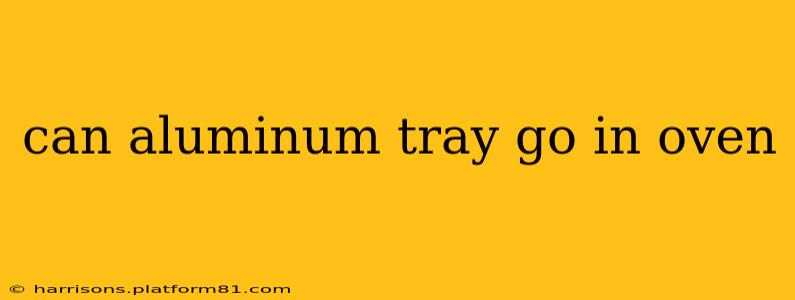Aluminum trays are a kitchen staple, offering convenience and affordability for baking, roasting, and more. But can you safely use them in the oven? The answer is a qualified yes, but it depends on several factors. This guide will delve into the specifics, addressing common concerns and ensuring you use your aluminum trays safely and effectively.
What Kind of Aluminum Tray?
Not all aluminum trays are created equal. The type of aluminum and its construction significantly impact oven safety.
-
Heavy-duty aluminum foil pans: These are generally safe for oven use, but with limitations. They are designed for single-use and can warp or melt at high temperatures. Avoid using them for extended periods or at temperatures exceeding 400°F (204°C).
-
Anodized aluminum trays: These pans have a protective coating that makes them more durable and resistant to heat. They can usually withstand higher temperatures and are often dishwasher-safe, offering better longevity than standard aluminum foil pans.
-
Heavy-gauge aluminum baking sheets: These are typically the most oven-safe option. They're sturdy, designed to withstand high heat, and can be used repeatedly.
What Temperature is Safe for Aluminum Trays in the Oven?
The safe oven temperature for an aluminum tray largely depends on its type.
-
Heavy-duty aluminum foil pans: Stick to temperatures below 400°F (204°C) for best results. Higher temperatures can cause warping or melting.
-
Anodized aluminum trays: These can generally handle higher temperatures, often up to 450°F (232°C), but always check the manufacturer's recommendations.
-
Heavy-gauge aluminum baking sheets: These are the most heat-resistant and can usually tolerate temperatures well above 450°F (232°C). However, excessively high temperatures can still lead to discoloration over time.
Can I Use Aluminum Foil Pans More Than Once?
While heavy-duty aluminum foil pans are often marketed as disposable, you can sometimes reuse them. However, keep in mind that repeated use will weaken the pan, making it more prone to warping and damage. Avoid reusing them if they show significant signs of wear, such as warping, perforations, or heavy discoloration.
What Happens If I Use an Aluminum Tray at Too High a Temperature?
Using an aluminum tray at too high a temperature can lead to several issues:
- Warping: The aluminum can soften and deform under extreme heat, resulting in a misshapen pan.
- Melting: Especially with thin foil pans, the aluminum can melt, creating a mess and potentially damaging your oven.
- Discoloration: High heat can cause the aluminum to darken or discolor, though this usually doesn't affect its functionality.
Are there any safety concerns with using aluminum trays in the oven?
While generally safe, some potential concerns include:
- Acidic foods: Highly acidic foods, like tomatoes or citrus juices, can react with the aluminum, potentially affecting the taste of your food. Anodized aluminum trays are less susceptible to this reaction.
- Aluminum leaching: While the amount is generally considered negligible, some aluminum can leach into food, especially at higher temperatures or with acidic foods. Using anodized aluminum trays can minimize this risk.
How do I clean aluminum baking trays?
Cleaning your aluminum baking trays is relatively straightforward. Hand washing with warm soapy water is often sufficient. Avoid abrasive cleaners or scouring pads, as they can scratch the surface. For stubborn stains, soak the tray in warm soapy water before scrubbing. Most anodized aluminum trays are also dishwasher safe.
By understanding the different types of aluminum trays and their limitations, you can safely and effectively use them in your oven for years to come. Remember to always prioritize safety and follow the manufacturer's recommendations for optimal results.
